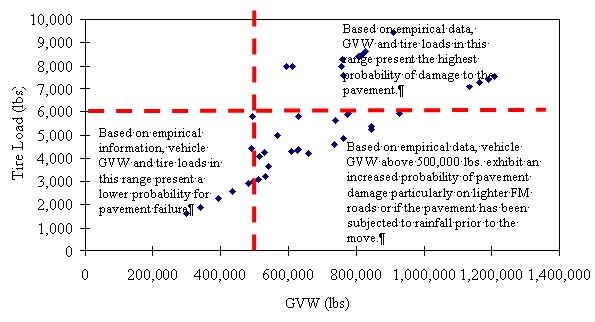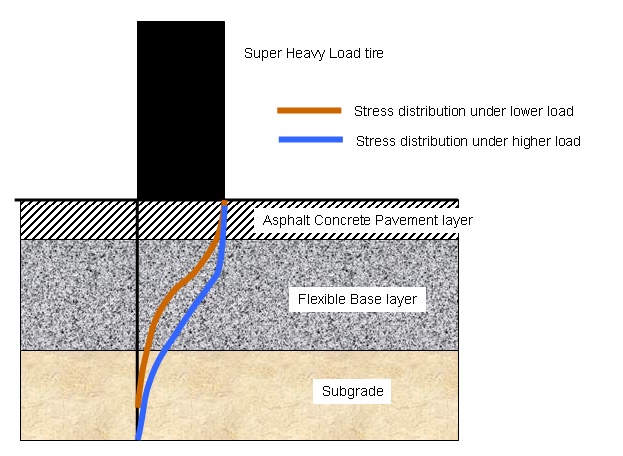Section 5: Super Heavy Load Analysis Background
Super heavy loads are defined as loads that exceed 254,300 lb. gross vehicle weight or exceed the maximum permissible weight on any axle or axle group, or exceed 200,000 lb. with less than 95 ft. of axle spacing. Some of the loads approach 2,000,000 lb. Due to the magnitude of these loads, there is a risk of causing severe pavement damage in one pass. All super heavy loads must be permitted through the Motor Carrier Division (MCD) of the Texas Department of Motor Vehicles. Empirical information obtained during field studies of super heavy load moves has provided the basis for the current evaluation threshold criteria established by the Maintenance Division, Pavement Asset Management Section.
Super heavy loads with GVW above 500,000 lb. and/or maximum trailer tire load above 6,000 lb. are analyzed by MNT – Pavement Asset Management. The super heavy load analysis threshold criteria for evaluation were established based on the occurrence of observed pavement distress and the super heavy load GVW and tire load, as well as practical limitations regarding the number of analyses that can be performed by MNT – Pavement Asset Management. Emphasis has been placed on analyzing super heavy loads with a greater potential for pavement damage. As depicted in Figure 13-1, the general observed trend is that as gross vehicle weight of the super heavy load increases, the load per tire increases. It is uncommon to have trailer tire loads greater than 6,000 lb. when the GVW is less than 500,000 lb.
Figure 13-1. General relationship in gross vehicle weight (GVW) and increased trailer tire load based on loading diagrams.
Flexible pavements, which constitute approximately 93% of the Texas highway system, typically are constructed with weaker materials at lower levels within the pavement structure. If these weaker materials are subjected to high stresses due to high tire loads, there is a greater chance for permanent damage to the pavement, such as rutting or cracking. As can be seen in Figure 13-2, as tire loads increase, the stress within the pavement structure increases throughout the structure, including the lower levels. For this reason, higher tire loads (established to be 6,000 lb.) are evaluated for super heavy loads, regardless of the gross vehicle weight.
Figure 13-2. Stress distribution within a flexible pavement structure for a low and high tire load.
As mentioned previously, the trailer tire load limit of 6,000 lb. was established based on empirical information related to observed distress which has occurred during super heavy load moves. In addition, approximately 6,000 lb. represents the highest manufacturer’s single tire load limit that has been observed to date for standard truck tires used on super heavy loads. Although a super heavy load with a standard single truck tire loaded to its capacity has not yet been observed, this arrangement could pose a high potential for damage, especially on thinner pavements. Also, as loads increase above 6,000 lb., super single tires may be employed by the carrier since they can carry loads exceeding 9,000 lb. Super single tires have been shown to cause more damage to a pavement than standard dual truck tires based on tests conducted by the Federal Highway Administration (FHWA) and the California Department of Transportation (CALTRANS).
Super heavy loads can also damage (by peeling up) new pavement surfaces (overlays and chip seals) that are less than 5 weeks old. It is the district’s decision to place a “no travel” restriction for newly placed seal coats on their pavements. The process allows movement over fresh seal coats, regardless of time since placement, if the district feels there will not be significant damage done to the new surface. If the district feels that the surface may sustain damage, the district may restrict super heavy movement, as long as the district can offer an acceptable reroute. If no reroute is available, then the original route will be used and TxDOT personnel will need to be present to document any damage, should it occur. The Texas Department of Motor Vehicles, Motor Carrier Division (MCD), will advise the carrier of fresh seal coat locations along a given route so the carrier can make arrangements to travel over these sections early in the morning. If this is not possible, spraying water or some other method to reduce the possibility of seal coat damage may be considered.
Upon receiving an email from MCD or MNT – Pavement Asset Management, the district pavement engineer will have three business days to alert MCD or MNT – Pavement Asset Management if a reroute is needed. MCD and MNT – Pavement Asset Management maintain a contact list provided by districts on who should be notified. If, after three business days, no reroute requests have been sent to MCD or MNT – Pavement Asset Management, the route will be considered approved and the permit application will continue to be processed. The exact date and time of the super heavy load move is difficult to know due to numerous factors. District personnel may take a proactive role and contact the carrier to obtain the date(s) of movement. For super heavy loads with a GVW over 500,000 lb., MCD requires the carrier to notify district personnel 48 hours prior to the move. Districts need to provide contact information for at least three of their employees to MCD and MNT – Pavement Asset Management to keep the list updated.
It is the responsibility of the carrier (permit holder) to check their total load and wheel load. The axle information can be found on the axle diagram MCD sends to the permit coordinator along with a copy of the permit. If required, an engineer or maintenance section employee can check the axle configuration to ensure that it matches the permit. Only the Department of Public Safety (DPS) or local law enforcement can verify the tire load since TxDOT has no enforcement authority. MCD should be the point of contact that notifies DPS when a load needs to be weighed.

